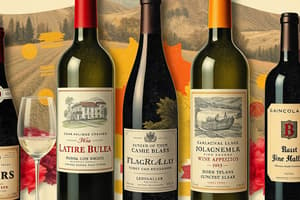Podcast
Questions and Answers
What are the main components of wine?
What are the main components of wine?
Grapes, alcohol, acid, tannin
What does the equation 'Sugar + Yeast = Alcohol + CO2' represent?
What does the equation 'Sugar + Yeast = Alcohol + CO2' represent?
- The harvesting process
- The bottling process
- The fermentation process (correct)
- The aging process
Tannin is mostly found in red wines.
Tannin is mostly found in red wines.
True (A)
Terroir is the complete natural environment in which a particular wine is produced, including factors like the _______, soil, and topography.
Terroir is the complete natural environment in which a particular wine is produced, including factors like the _______, soil, and topography.
Match the following wine-making processes with their descriptions:
Match the following wine-making processes with their descriptions:
Flashcards are hidden until you start studying
Study Notes
What is Wine?
- Wine is made from grapes, which contain sugar, acid, and tannin.
- The winemaking process involves converting sugar into alcohol through fermentation.
Grapes
- There are between 5,000 to 10,000 grape varieties, but only about 150 are commercially significant.
- Grape varieties can come from natural mutations, intentional crosses, or a combination of both.
Terroir
- Terroir refers to the natural environment in which a particular wine is produced, including climate, soil, and topography.
- Climate factors include precipitation, temperature, humidity, sunlight, and frost, which affect the acidity and flavor profile of the wine.
- Soil factors include the direction or orientation of the soil, drainage, and irrigation, which impact the flavor and acidity of the wine.
- Topography refers to the three-dimensional aspect of a site, including slopes, valleys, and mountains, which affect the growth of the grapes.
Understanding Terroir
- Old World wines (e.g., from Europe) tend to be more earth and mineral-driven, while New World wines (e.g., from the Americas) tend to be fruit-driven with higher alcohol levels.
- The same variety of grape can express itself differently depending on the region it's grown in.
Wine Making Process
- The winemaking process involves several stages: ripening, harvesting, crushing and pressing, fermentation, racking, filtering and fining, and maturation/aging.
- The ripening process involves the change of color of grape berries, known as veraison, and the increase in sugar and decrease in acidity.
- Harvesting involves picking grapes at the optimal time to balance sugar, acidity, and tannin levels.
- Crushing and pressing involves sorting, crushing, and pressing grapes to extract the juice.
- Fermentation involves converting sugar into alcohol through the action of yeast.
- Racking, filtering, and fining involve clarifying and stabilizing the wine.
- Maturation and aging involve allowing the wine to develop its flavor and character over time.
The Impact of Oak
- Oak can affect the color, flavor, tannin profile, and texture of wine.
- Oak can come into contact with wine in the form of a barrel during fermentation or aging periods.
- New oak imparts more flavor and tannin than old oak.
How to Taste Wine
- The tasting process involves looking, swirling, smelling, tasting, and concluding.
- Looking involves visually inspecting the wine to assess its age, oxidation, rim variation, transparency, and color density.
- Swirling involves aerating the wine to release its aromas.
- Smelling involves identifying the aromas and flavors of the wine.
- Tasting involves assessing the flavors, body, acid, tannin, and sugar levels of the wine.
- Concluding involves assessing the overall balance and enjoyment of the wine.
Studying That Suits You
Use AI to generate personalized quizzes and flashcards to suit your learning preferences.




